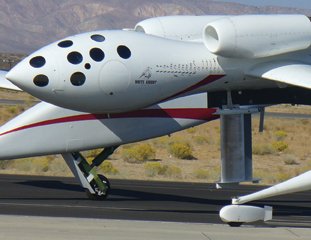Morphing a Wing to Save Fuel
Airplanes of the future might change the shape of their wings as they fly.
Share this:
- Share via email (Opens in new window) Email
- Click to share on Facebook (Opens in new window) Facebook
- Click to share on X (Opens in new window) X
- Click to share on Pinterest (Opens in new window) Pinterest
- Click to share on Reddit (Opens in new window) Reddit
- Share to Google Classroom (Opens in new window) Google Classroom
- Click to print (Opens in new window) Print
By Emily Sohn
Airplanes of the future might change the shape of their wings as they fly.
A Michigan-based company called FlexSys has created shape-shifting wings that recently performed well in flight tests. And these special wings do more than just look cool. The tests found that aircraft with morphing wings are likely to use less fuel than do traditional airplane designs.
 |
|
A silver-colored test wing, mounted vertically beneath a jet, has a changeable trailing edge. Its developers completed flight tests of this new wing last month. |
| FlexSys |
“This is something that the aerospace community has been after for a long time,” says aerospace engineer Peter M. Flick of the Air Force Research Laboratory at Wright-Patterson Air Force Base near Dayton, Ohio.
Flick heads the program that’s funding the wing’s development.
Some military jets, such as the F-111, already have wings that can change shape. The old technology, however, is bulky, heavy, and impractical for wide use.
FlexSys, instead, decided to put a specially designed network made of aluminum inside its wings. Aluminum is a lightweight metal.
Inside the wing, the metal network bends in response to forces exerted by a simple system of motors and rods. This causes the wing’s edge to curve smoothly either up or down.
During tests inside wind tunnels last spring, the new wings stood up to forces that were three times as strong as those that airplanes normally experience in flight.
In the just-completed flight tests, a jet called the White Knight took a test wing up to altitudes between 8,000 meters (26,300 feet) and 12,000 meters (39,400 feet). The White Knight previously helped launch the first manned, privately built vehicle into outer space (see “Reach for the Sky“).
Once up there, the wing’s edge flexed as sensors measured how aerodynamic, or streamlined, it was in various positions.
Researchers expect the flexible wings to be useful in spy planes. These robotic planes often hover for long periods of time at very high altitudes, and they burn a lot of fuel as they sit there.
As an aircraft’s fuel is used up, the airplane loses weight, and that changes how aerodynamic the vehicle is. By changing the shape of its wings, a stealth spy plane could reduce drag, save fuel, and stay in flight longer.
Commercial airplane companies have also expressed interest in the technology. Someday, your view of the wing from a window seat might be just as action-packed as the in-flight movie.—E. Sohn
Going Deeper:
Weiss, Peter. 2006. Ahead of the curve: Novel morphing wing may reduce aircraft’s fuel use. Science News 170(Dec. 23):406. Available at http://www.sciencenews.org/articles/20061223/fob8.asp .
You can learn more about morphing wings at www.flxsys.com/Projects/MACW/ (FlexSys).
Lock, C. 2004. Are propellers fin-ished? Science News for Kids (Sept. 15). Available at http://www.sciencenewsforkids.org/articles/20040915/Feature1.asp .
Ramsayer, Kate. 2004. Reach for the sky. Science News for Kids (Dec. 1). Available at http://www.sciencenewsforkids.org/articles/20041201/Feature1.asp .
LabZone
http://www.sciencenewsforkids.org/articles/20050914/LZActivity.asp
http://www.sciencenewsforkids.org/articles/20040728/LZActivity.asp






